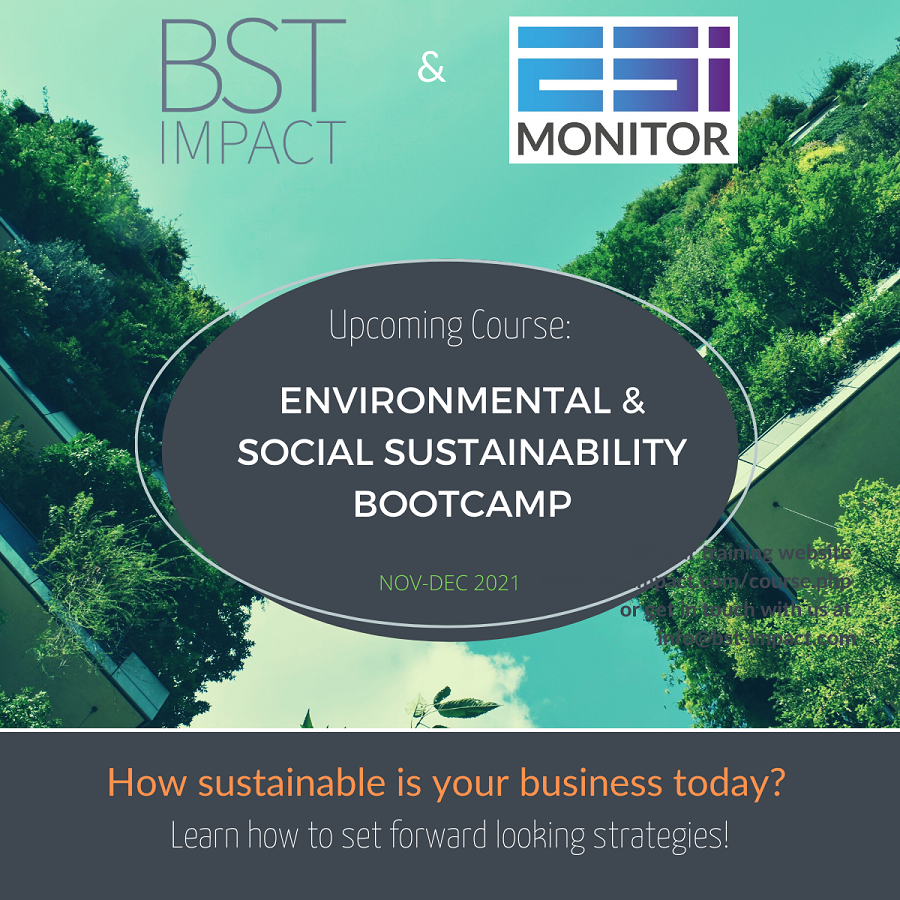
ESG From a Norms-Based Perspective.
The environment (E) has a polar bear on melting ice as a powerful metaphor. Everybody understands that image and understands the urgency needed to DO something to, at this point not only prevent but to actually reverse, the climate crisis and global heating. That is if we want to hand over a livable world to the next generation. It is also – relatively – “easy” to measure environmental impact, scary as the measurements may be.
But the social (S) seems at times to have a harder time becoming concrete. How do you measure impact on society? On individuals and groups? G (Governance) criteria can be discerned from general corporate governance principles and long experience. But for the S, the indicators are often too diverse and fragmented because the way in which the S is conceived by different data providers lacks a common principled basis. But what is the equivalent to the polar bear image? How do we make a thing as complex as society and social impact simple? Is it the picture of a child who works in a mine? Workers in sweat shops? It can be, but the S is broader than that and probably we have a difficult time finding the ONE image. Also because while we can all relate to the polar bear – none of us looking like him/her – we will not all look like the child in the mine or the worker in the sweat shop, and thus it becomes possible to think “that is terrible but that is not me, I cannot become that, thus it regards me only to a certain extent.” But what we can do is to link the S to very solid rights. Rights which at times are considered as fluffy as the S but which really are quite extraordinarily concrete.
ESG from an investor perspective is a translation of the Sustainable Development Goals (SDGs) engagement of a company into what financial analysts measure as ESG performance, and it is clear that investors have a growing appetite to benchmark companies against each other in terms of that performance. There is a recognition of the fact that there is no reaching the SDGs without a rights-based approach and by taking action to address systemic rights issues in workplaces, value chains and the societies in which they operate, sell and invest companies can lift people out of poverty, discrimination and abuse. Anchoring the S within a rights language and a rights-based approach also helps us understand what the S in ESG actually is. As with the SDGs, there can be no real ESGs if we do not put the Rights squarely in the middle – or rather squarely as a foundation.
At times human rights are listed as only one point under “S” instead of being understood as the foundation for sustainability – and most certainly as the foundation for the “S”. Human rights and a rights-based approach must be understood as underpinning the efforts made both on E and S and incorporated into G – thus it may be most clearly found under “S” but it really must be mainstreamed into all components. Rights cannot be an isolated pillar but must be connected throughout the ESG discourse. But clearly it is the S that is directly about “people”. Even if it would be meaningless to disassociate it from the E and G – people live in the Environment and influence the Environment. It is clear that countries in which living standards for people are high there is an increased focus on how to be ecological, how to recycle how to buy more responsibly. Because the people have the possibility to not only focus on the next meal, people get the necessary education to make these choices and have the possibility to say “no” to jobs in industries that damage the environment and to even influence political decisions on whether such industries can operate in society and how.
For any company focusing on the S means focusing on workers, including in supply chains; customers; and people in affected communities – largely speaking those are the communities in which they operate both when producing as well as selling. If the S is about human beings – individually, as groups and making up societies – then the guidance on how to promote S is clearly linked to respect for rights. Countries with higher degrees of respect for rights experience higher economic growth rates and higher levels of human development. Broadly speaking human rights standards also set up a framework which protects consumers, including by guaranteeing participation and socio-economic rights which underpin prosperous and safe societies, thus respect for rights is important both for good production conditions as well as good consumption conditions.
BlackRock CEO Larry Fink and Bank of England Governor Mark Carney have underlined that maximizing shareholder value is vastly insufficient if not destructive as a business model. They both emphasize that companies must serve a broader social purpose. Fink stated in his 2019 CEO letter: “Purpose is not a mere tagline or marketing campaign; it is a company’s fundamental reason for being – what it does every day to create value for its stakeholders.” And in 2020 BlackRock clearly made sustainability a part of their investment strategy. For a business to be sustainable, its purpose needs to reflect concern not only with financial capital, but also its impact on human capital, social capital, and natural capital. A corporation has to be reconceived as an entity existing in society – not only a contract between the private parts of the firm aiming at making profit short term. Insurance companies also note how respect for rights are good business. Allianz has stated how many of the direct human rights risks and issues faced by the finance sector are generic to all businesses, such as the treatment of its own employees. But as an investor into public and private entities and an insurer of multinational corporations from various sectors, the insurance industry also plays an active role in the global economy. The insurance company has realized how failure to respect human rights exposes the insurance industry to reputational, legal and transactional risk.
Stakeholders, including civil society and policy makers, have rising expectations of how companies should be approaching the topic and their responsibility. For example, operating in locations prone to human rights violations may invite criticism from non-governmental organizations, as well as employees and customers. Human rights standards are increasingly being built into international agreements and local regulations. Furthermore, there is often a strong correlation between respecting human rights and the quality of the insured risks. Also on the investment side, investors who take environmental, social and governance (ESG) considerations into account in their investment decisions, experience improved risk-adjusted investment returns in the long term.
Considering ESG enables investors to identify new sets of financial risks and opportunities. Investors who consider ESG criteria have a more profound insight of an enterprise’s operations, since the due diligence process will take into account a much broader range of information. This allows investors to better manage the risks linked to human rights violations. Such risks can often result in significant financial impact, including potential impact on the reputation and brand of a company, with repercussions on sales, and legal sanctions on companies and their suppliers. As well as the broader impact on societies that denial of rights of individuals/groups will have. This effect has become excruciatingly clear with the covid-19 pandemic. The effects of no universal health care, of no living wage, of no social security, of lack of respect for workers’ rights have been clearly exposed. And so have the effects of this inequality on the recovery of societies and economies. Those spiraling quickly into poverty because they already lived in insecurity without effective respect for their rights will not be able to quickly bounce back and take active part in the recovery of the economy. Many these days talk about building back better after the crisis. Building back better means putting the Rights squarely where they belong; underpinning all decisions made at the political, corporate and investor level. And realizing how putting the R in ESG makes the S a lot less fluffy but rather something that can be measured and something that if not implemented has very serious consequences – including for medium/long term financial gains (or losses).
Interestingly, in the moment of writing during the pandemic, when markets have taken a down-turn, the Financial Times just noted how ESG investing has been less impacted: “The evidence so far suggests that ESG has been more resilient. ESG funds have also withstood the market sell-off better than most others.” The Wall Street Journal has noted that “environmental, social and governance investing was growing in popularity before the virus began to circulate, as investors flocked to companies that have taken steps to manage non-financial risks related to matters such as climate change, board diversity or human rights issues in the supply chain. A group of 300 mutual funds that integrate ESG factors into their investment decisions attracted $21.4 billion in new money in 2019, compared with $5.4 billion a year earlier, according to data from Morningstar Inc. Meanwhile, in a note to clients Citigroup Inc. said investors are asking more questions about issues such as employee benefits and mortgage relief, with the goal of identifying corporate strategies to limit the economic damage from the pandemic.”)
Putting Rights as a foundation for ESG and understanding how they make the S much more concrete will not help us find the equivalent of the polar bear… there are too many facets and too many pictures that could show what happens when Rights are NOT respected. But it means making the S concrete; do people have a level of education that makes it possible to make informed choices, and to have choices in the first place? Do people have access to health care? Do people have access to food? Do people have access to housing? Are people participating in political processes? Are there mechanisms in place to address violation of rights, and are they accessible? Human Rights standards provide a basic list of potential indicators. The S is not abstract. Nor are Rights. And investors are showing an increasing understanding for how concrete the S (squarely founded on Rights) can be for them and the societies in which they live.







